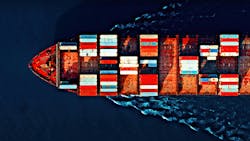Tariff tsunami: How to predict the unpredictable
Key highlights
- Current tariffs primarily impact component availability more than price, but this will shift, necessitating proactive supply-chain management to avoid production halts.
- Engineers should assess and prioritize domestic alternate supply chains for components that don't compromise product differentiation to mitigate tariff risks.
- Rapidly implementing price adjustments due to tariffs and strategic customer communication are crucial to maintaining profitability and strong client relationships amidst market volatility.
A Control Design reader writes: Here we go again. It was just a year or so ago that we’d recovered from the supply-chain shortage caused by the COVID shutdown. Now we’re looking at a different kind of potential shortage with tariffs about to raise the price of foreign components. We already diversified our supply chain as a result of the COVID backlog. What type of supplier assistance will be available for components and materials?
Also, is anyone else concerned about reciprocal tariffs impacting their business in foreign countries? Any advice is appreciated. How do we prepare for all of this?
Answers
How long can you wait out the volatility?
At this point, the tariffs are impacting availability more than price, but that will change with time, if the tariffs stay in place. We are seeing importing companies simply cancel incoming international shipments due to the uncertainty, hoping the tariffs will be lower in the future. At some point, they will run out of inventory and be forced to pay, but right now the situation is too volatile to commit to paying the price.
David Vasko, senior fellow / 5 Lakes Institute
Be prepared
- Create a strategy with market share and/or profit goals. Some product lines may be able to absorb some of the increased costs, while you may choose to pass costs through to others. In those cases, execute quickly. If you’re too slow to act, you’ll start losing profits and become uncompetitive in the market.
- Review your contracts to understand legal restrictions. Find out where you’re locked into contract terms and where you have flexibility to make price adjustments or renegotiate.
- Assess and consider alternate supply chains. If switching component suppliers would sacrifice or change your differentiation, do not go down that path. Get a sense of which components can be purchased domestically and the impact to the end customer, by product line, to help create your plan.
- Monitor your competitors. See if you can find out how much they are importing, and if they’re changing suppliers. If you’re able to get a local supplier without impacting your differentiation, see if you can secure a sole supplier relationship. This may create an advantage against competitors.
- Gauge your pricing power by account. You need to understand where you can raise prices without losing market share. Start by looking at your accounts by buyer type and transaction history to better understand their likelihood to stay with you and how to approach your strategy and communication plan. If they’ve historically been a relationship buyer or value buyer, keep that in mind when creating a strategy for that account.
Get your subscription to Control Design’s daily newsletter.
Key considerations:
- When implementing an increase due to tariffs, do so quickly.
- Plan for what portion of the tariff you will absorb for which customers. Can you switch some customers to different products or add services to incentivize them to stay with you?
- Identify unprofitable customers and use this time to calibrate on fair pricing where you’re underpaid. Ensure you get a fair increase, choose a walkaway price, and stick to it.
- Tariffs can be temporary. How you manage them can help differentiate you and your relationships with customers at a time of major volatility. They’ll remember how you partnered with them during this time.
- Prepare with “give-gets” and “good-better-best” structures to give the buyer choices and keep them in the driver’s seat. Make sure you have a flanking low-value offering for those who are true price buyers and for those bluffing to get a better deal.
Brian Doyle, president & CEO / Holden Advisors, partner member of the Control System Integrators Association (CSIA)
About the Author
Mike Bacidore
Editor in Chief
Mike Bacidore is chief editor of Control Design and has been an integral part of the Endeavor Business Media editorial team since 2007. Previously, he was editorial director at Hughes Communications and a portfolio manager of the human resources and labor law areas at Wolters Kluwer. Bacidore holds a BA from the University of Illinois and an MBA from Lake Forest Graduate School of Management. He is an award-winning columnist, earning multiple regional and national awards from the American Society of Business Publication Editors. He may be reached at [email protected]

Leaders relevant to this article:

